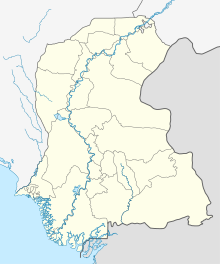This is the current revision of this page, as edited by Marcocapelle (talk | contribs) at 22:17, 17 December 2024 (→References: More specific categorization). The present address (URL) is a permanent link to this version.
Revision as of 22:17, 17 December 2024 by Marcocapelle (talk | contribs) (→References: More specific categorization)(diff) ← Previous revision | Latest revision (diff) | Newer revision → (diff) 8th century battle between Umayyads and Brahmin dynasty of Sindh| Battle of Aror | |||||||
|---|---|---|---|---|---|---|---|
| Part of Umayyad conquest of Sindh | |||||||
 Indus river near Aror | |||||||
| |||||||
| Belligerents | |||||||
|
| Kingdom of Sindh | ||||||
| Commanders and leaders | |||||||
|
| Raja Dahir † | ||||||
| Strength | |||||||
| 20,000 |
20,000–25,000 50,000 (modern estimates) | ||||||
  | |||||||
The Battle of Aror took place in 711 AD between the Umayyad forces under Muhammad ibn al-Qasim and the army of the Brahmin dynasty of Sindh under Raja Dahir. It was the last military conflict of Raja Dahir, in which the Umayyads defeated his army near the Indus River and resulted in the death of Dahir.
Battle
The battle took place on the left bank of the Indus. The names of that place on those occasions were Jiwar, Bet, and Rawer. After besieging Debal, Muhammad ibn Qasim joined with 2,000 cavalry from Persia in addition to the rest of his forces making it 20,000 men, and marched towards Aror. He was opposed by Raja Dahir's forces. According to the Chach Nama, the strength of the forces was 20,000-25,000. According to modern historians such as K. S. Lal, the forces included not less than 50,000 men.
Qasim, seeing the imbalance, took advantage of the ground. He waited for Dahir to attack after getting in a good position. During the battle, a fireball struck Dahir's elephant, and the elephant bore Dahir off the field. Even though Dahir fought, he was killed by an arrow in his neck and his army faced high casualties, resulting in an Umayyad victory.
Aftermath
After the victory, Muhammed ibn Qasim found the body of Raja Dahir and sent it to Al-Hajjaj. He later dispatched his army to besiege the fort of Rewar. Since his son had retreated to Brahmanabad in war, the queen of Raja Dahir, Rani Bai committed jauhar to avoid being captured by the army of Mohammed Qasim.
See Also
- Battle of fort Rewar
References
- Khushalani, Gobind (2006). Chachnamah Retold : An Account Of The Arab Conquest Of Sindh. Bibliophile South Asia. p. 127. ISBN 9788185002682.
- Sāvitrī Kotūmal Mansukhānī, Rāmu Amarlaʻlu Panjvāṇī (2002). Sindh land of hope and glory. Har-anand publication. p. 103. ISBN 9788124108468.
- Journal of the Asiatic Society of Bengal. Soc. 1887. pp. 330–331.
- Rapson, Edward James; Haig, Sir Wolseley; Burn, Sir Richard; Dodwell, Henry (1958). The Cambridge History of India: Turks and Afghans, edited by W. Haig. S. Chand. p. 5.
- Wynbrandt, James (2009). A Brief History of Pakistan. Infobase Publishing. p. 48. ISBN 978-0-8160-6184-6.
- ^ Lal, Kishori Saran (1984). Early Muslims in India. Books & Books. pp. 14–19. ISBN 978-81-85016-08-5.
- ^ Satyapal; Chandra, Prabodh (1946). Sixty Years of Congress: India Lost; India Regained, a Detailed Record of Its Struggle for Freedom. Lion Press. pp. 32–36.
- ^ Mehta, J. L. Vol. Iii: Medieval Indian Society And Culture. Sterling Publishers Pvt. Ltd. p. 12. ISBN 978-81-207-0432-9.
- Kadyan, Amir (2020-04-02). Know The Jat. BlueRose Publishers. p. 10.